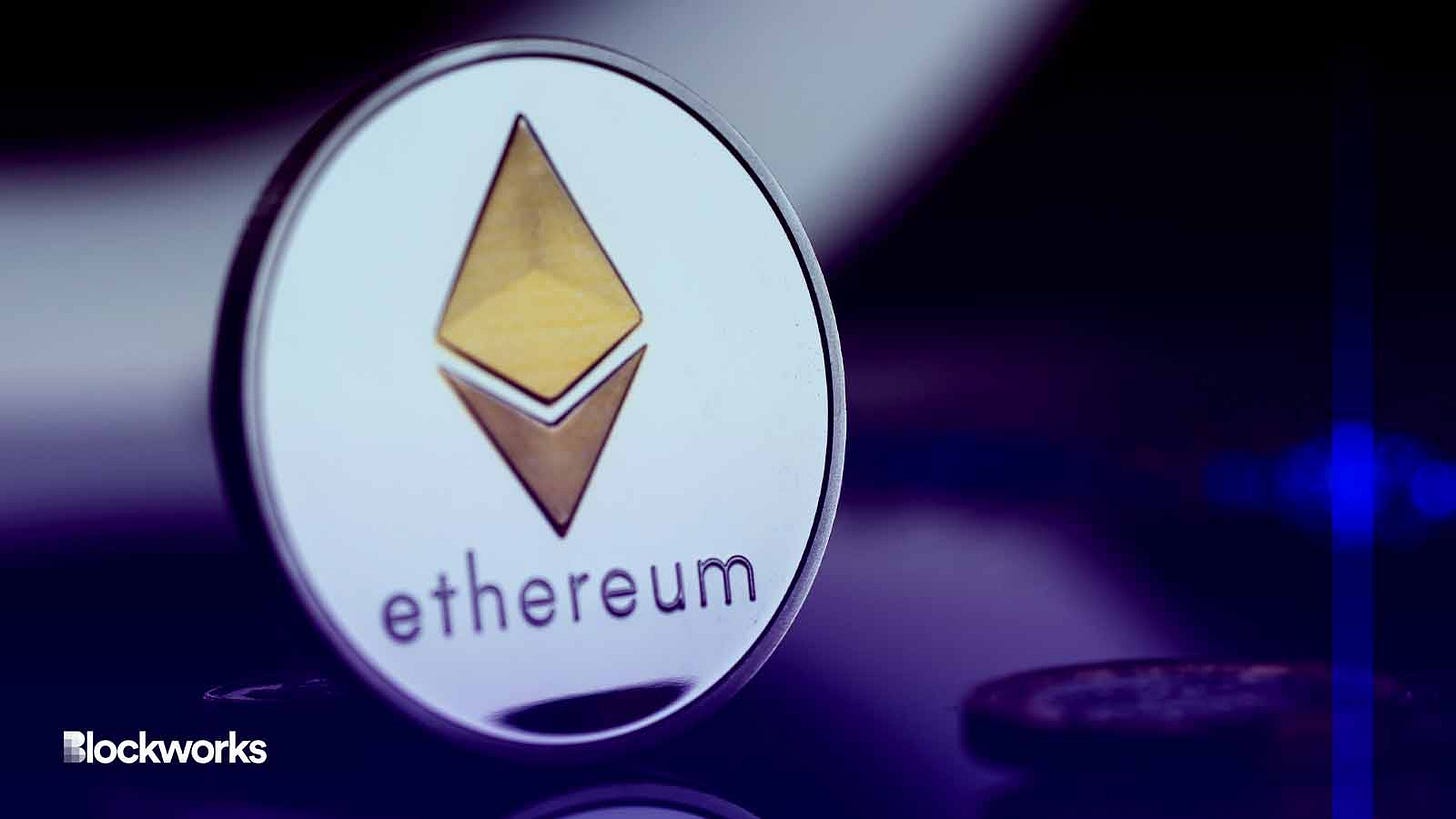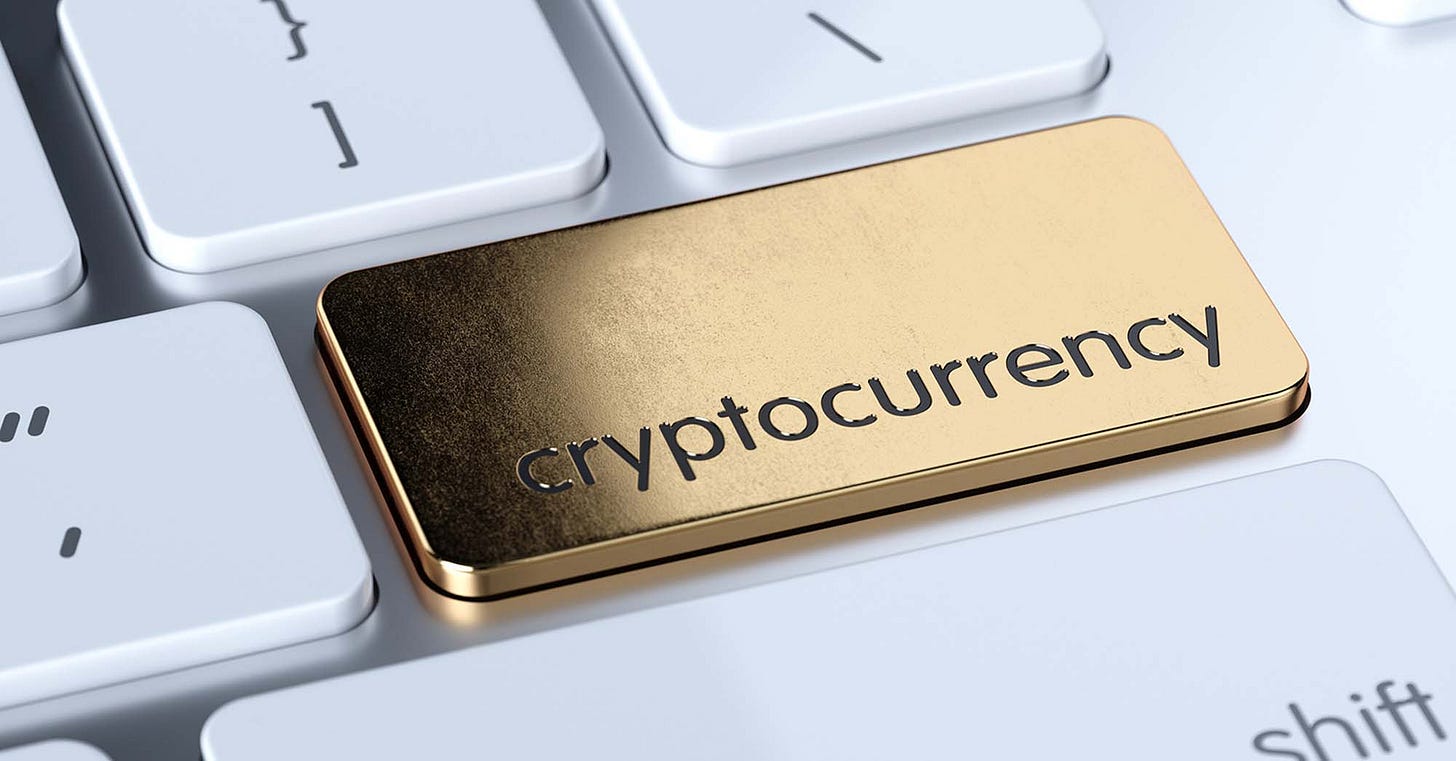Welcome to The Wolf Den! This is where I share the news, my ideas about the market, technical analysis, education and my random musings. The newsletter is released every weekday and is completely FREE. Subscribe!
Sign up for my other newsletter, THE DAILY CLOSE!
I built The Daily Close to give you the same institutional-grade indicators and signals that I use to trade the market on a daily basis. It's automatically generated and delivered to your inbox at the daily close everyday.
1 Week FREE for all subscribers
17% discount if you subscribe for a year
$25 a month, or $250 a year
In This Issue:
The Ethereum Investment Thesis
Grayscale's Victory & Large Investors Accumulate - IntoTheBlock
Bitcoin Thoughts And Analysis
Legacy Markets
The Bitcoin Rainbow Chart Failed?
The First Spot ETH ETF Has Been Filed!
Open Up The Flood Gates, Corporations Can Finally Buy Bitcoin
Bitcoin Is In Opportunity Zone | But Here Is Why You Should Buy Ethereum Now
The Ethereum Investment Thesis
In yesterday's newsletter, I discussed the noteworthy similarities between 2019 and 2023 in terms of market cycles. I maintain the notion that from a cyclical perspective, these two years share remarkable parallels. However, it's crucial to highlight a significant divergence: institutional involvement.
In 2023, institutions are demonstrating a substantial interest not only in Bitcoin but in a variety of aspects of the crypto space, including DeFi, stablecoins, and real-world applications. In today's newsletter, I will delve into the perspective of the world's third-largest asset manager, boasting $4.2 trillion in assets under management (AUM), on Ethereum. Allow me to introduce Fidelity's Ethereum Investment Thesis.
Fidelity’s research is a thorough 18 pages long, so my plan here is to skip to all the highlights to share with all of you. If you want to read the full report, you can do so HERE. The driving question behind the research is as follows: “how does utility translate into value for ether the token?” In other words, why would an investor buy and hold ether the token, rather than just use it to interact with the Ethereum network?”
There’s nothing investors love more than discussing the root of an asset’s value, so let’s dive in.
The Differentiating Factor
Ethereum has undergone significant evolution throughout its history, yet its fundamental value proposition has remained consistent, centered on its smart contract functionality. Vitalik Buterin departed from Bitcoin due to its limited programmability and has since ensured that Ethereum fulfills this commitment. Ethereum stands as the foremost platform for developing mainstream crypto applications. It transcends being merely an alternative form of currency; as Fidelity calls it, Ethereum is an “aspiring alternative money.”
Ethereum’s alternative uses, which do not exist on Bitcoin, such as facilitating more complex transactions, give it a unique, money-like utility that should be considered. While ether is commonly transferred between addresses to send value similarly to bitcoin, ether’s additional role as the currency by which users execute smart contract logic is its true differentiating factor.
Mainstream applications being used on top of Ethereum would, by default, lead to demand for the ether token, which is why this longer-term trend could be one of the most compelling cases for ether as an aspiring alternative money.
Sticky Demand
Ethereum is one of the most battle-tested cryptocurrencies, second only to Bitcoin. It provides an unmatched safe haven for innovation, which is precisely why developers have chosen to remain steadfast. As Fidelity explains below, price alone is not a reliable indicator of demand. As we'll delve into further, the true value of Ether is derived from alternative sources, rather than the basic demand for holding the asset.
Despite a bear market, Ethereum layer 1 transactions have remained quite steady at around 1 million transactions per day, while the price of ether has decreased 52% since the beginning of 2022. Additionally, there has been an uptick in layer 2 transaction volumes, while layer 1 volumes have held up. This may be signaling that there is a level of sticky demand on the base layer, while new demand is originating on layer 2s. This trajectory could suggest that value will continue to reliably accrue to the base layer even as layer 2s become more mainstream.
The Usability Layer
Ethereum's capacity for innovation continues to astonish even the most experienced DeFi investors. NFTs emerged unexpectedly and made an enormous impact on the art industry. Gamblers are discovering novel avenues for unconventional wagers through smart contracts, and the foundation of stablecoins relies on a dependable layer one for transactions. Furthermore, Ethereum has paved the way for DApps, lending platforms, ERC-20 tokens, and privacy solutions, just to name a few.
Ethereum’s core value arguably comes from the usability layer, which is not effectively captured in a model measuring adoption via addresses rather than measure of transactions, volume, or usage.
Fees and ether value accrual should be inherently related over the long term. An increased number of Ethereum use cases creates greater demand for block space, which leads to higher fees and greater value and utility in the form of yield rewarded to validators.
• MakerDAO (a project built on the Ethereum blockchain) purchased $500 million
• The first U.S. house sold on Ethereum was done as a non-fungible token (NFT)
• European Investment Bank issued bonds on-chain (directly on the blockchain)
• Franklin Templeton’s money market fund that uses Ethereum and Polygon to process transactions and record share ownership
While I could provide a summary of Ethereum's success, why not let a multi-trillion-dollar asset manager do the talking? If Fidelity is bullish on Ethereum, it's hard not to share their sentiment. The endorsement couldn't be more clear.
There is virtually no doubt that Ethereum is a leading blockchain technology platform that enables developers to build decentralized applications, many of which are capable of things that could not be done on Bitcoin’s network due to Ethereum’s superior programmability. This has led to some of the largest and most active applications in the digital asset ecosystem being built on Ethereum and the ether token continuing to hold the second-largest market cap position (behind only bitcoin) for years.
However, the question investors are asking is, “does this increased developer and application activity translate to value for ether the token?” We have shown that, in both theory and data thus far, increased activity on Ethereum’s network drives demand for block space, which, in turn, generates cash flow that can accrue to token holders. What is also evident, though, is that these various drivers are complex, nuanced, and have changed over time with various protocol upgrades and the emergence of scaling developments, like layer 2, and may change again in the future.
Last but not least, please read the news section below for more big news on Ethereum, you won’t want to miss it.
Grayscale's Victory & Large Investors Accumulate - IntoTheBlock
In this report, we bring to you the latest in on-chain cryptocurrency analysis. We look at the blockchain directly and analyze balances, transactions, and the overall activity of market participants. This gives us a unique insight into the future of the market.
This section is written in conjunction with IntoTheBlock (ITB). ITB is an intelligence company that leverages machine learning and advanced statistics to extract intelligent signals tailored to crypto-assets. IntoTheBlock tackles one of the hardest problems in crypto: to provide investors with a view of a crypto asset that goes beyond price and volume data.
The Wolf Den research team uses IntoTheBlock to dig deeper and get the most important insights about the crypto market.
Grayscale's Victory & Large Investors Accumulate
This week, we delve into the court's decision that supports Grayscale. We assess the performance of GBTC and examine on-chain data uncovering the positioning of institutional Bitcoin investors. In June 2022, Grayscale filed a lawsuit against the SEC following their rejection of Grayscale's request to convert its GBTC fund into an ETF. More than a year later, just last week, the US courts unanimously ruled against the SEC's decision with a 3-0 verdict, declaring it as "arbitrary and capricious." The favorable ruling for Grayscale resulted in a GBTC rally, and for a brief period, it also lifted the rest of the market.
Via ITB's Free Capital Markets Analytics
Reducing the Discount - In 2023, the price of GBTC in relation to its Bitcoin holdings has been on the rise.
GBTC has seen its value surge by 124% this year, which is more than twice the 56% increase seen in Bitcoin.
Following their victory in the court case, GBTC's discount has reduced to 18%, marking its lowest level since December 2021.
The decreasing discount indicates that the market is increasingly optimistic about Grayscale successfully transitioning to an ETF. This transition would allow users to redeem their BTC at par value, potentially closing the discount gap to zero through arbitrage opportunities.
Via ITB's Bitcoin Concentration Indicators
While the approval for GBTC's conversion into an ETF is pending, there are indications that institutional investors are growing more optimistic about Bitcoin as the ETF decisions stand nearer.
Wallets possessing 0.1% or more of the total Bitcoin supply have increased their BTC holdings by more than $1.5 billion in the past three weeks.
There was an initial surge in accumulation, with 24,000 BTC being added after the price dropped to $25,000. This was followed by another uptick on August 23, and finally, a significant increase of 20,000 BTC on the day of the Grayscale ruling.
Despite the court's favorable decision for Grayscale, it seems that Bitcoin prices have returned to approximately the same levels they were at before the ruling. This situation raises some uncertainty regarding the future direction of Bitcoin's price. However, the accumulation by institutional holders indicates their continued optimism in the market.
Bitcoin Thoughts And Analysis
There is nothing to talk about here. Bitcoin has been the same price every day!
The Dollar Rages On, Stocks Feel The Heat
My base case is that stocks topped a few weeks ago - for a while. I dare not attempt to call the top, but I had high conviction that a correction was coming. I publicly sold off a number of positions that I bought way lower in this cycle (investments intact, of course). The DXY continues to rage, showing serious strength. Currently attempting a break above the 50 MA and making a higher high for the first time since the top. Bear market structure is breaking. A strong dollar usually means a weak stock market. Remember, the stock market is NOT the US economy.
Now for the summary of the day.
U.S. stock futures have declined due to increased speculation on further Federal Reserve policy adjustments. Apple Inc.'s shares slid by 2% in anticipation of China's plan to prohibit iPhones in some of its government agencies. While the Stoxx 600 in Europe remained stable, ending its six-day loss streak, the dollar achieved a six-month high, driven by strong U.S. economic growth data. On the other hand, China's yuan weakened to its lowest in 16 years despite the People's Bank of China setting its daily reference rate stronger than expected for over 50 consecutive days. The effectiveness of such monetary tools is questioned amidst a stagnant Federal Reserve stance and a slowing Chinese economy. European stocks showed some resilience despite Germany's industrial slump. Meanwhile, oil prices dropped, ending a nine-day upward trend, and gold prices slightly increased.
Key events this week:
China forex reserves, Thursday
Eurozone GDP, Thursday
US initial jobless claims, Thursday
Bank of Canada Governor Tiff Macklem to speak on the Economic Progress Report, Thursday
Atlanta Fed President Raphael Bostic speaks, Thursday
New York Fed President John Williams participates in moderated discussion at the Bloomberg Market Forum, Thursday
Japan GDP, Friday
Germany CPI, Friday
US wholesale inventories, consumer credit, Friday
Some of the main moves in markets:
Stocks
The Stoxx Europe 600 was little changed as of 10:57 a.m. London time
S&P 500 futures fell 0.2%
Nasdaq 100 futures fell 0.6%
Futures on the Dow Jones Industrial Average were little changed
The MSCI Asia Pacific Index fell 0.7%
The MSCI Emerging Markets Index fell 0.7%
Currencies
The Bloomberg Dollar Spot Index was little changed
The euro fell 0.1% to $1.0715
The Japanese yen rose 0.1% to 147.45 per dollar
The offshore yuan fell 0.2% to 7.3353 per dollar
The British pound fell 0.3% to $1.2467
Cryptocurrencies
Bitcoin rose 0.2% to $25,726.84
Ether rose 0.2% to $1,630.82
Bonds
The yield on 10-year Treasuries declined one basis point to 4.27%
Germany’s 10-year yield declined three basis points to 2.63%
Britain’s 10-year yield declined seven basis points to 4.46%
Commodities
Brent crude fell 0.8% to $89.91 a barrel
Spot gold rose 0.2% to $1,920.18 an ounce
The Bitcoin Rainbow Chart Failed?
In response to that question, my answer is ‘No.’ Firstly, it's crucial to understand that the Bitcoin Rainbow chart doesn't rely on scientific theories or real-world calculations. Instead, the Bitcoin Rainbow Chart, in all its variations, is essentially a playful logarithmic graph superimposed onto Bitcoin's price history.
Secondly, one might ask, where has the chart fallen short? I've consistently referred to the version created by BlockchainCenter.Net, the original creator of this concept. I acknowledge that Version 1.0 was abandoned, but even in such circumstances, is there really a need for alarm? Version 2.0 remains intact and continues to be the version we've all been utilizing.
Ultimately, this chart is an entertaining idea; it may prove accurate, or it may prove otherwise. Honestly, it just looks cool.
The First Spot ETH ETF Has Been Filed!
We anticipated the day when asset managers would shift their focus towards Ethereum to introduce an ETF, and that day has arrived much sooner than any of us could have predicted. Ark Invest, under the leadership of Cathie Wood, has joined forces with 21Shares to become the initial filers for an Ethereum ETF. It's worth noting that this filing is designated as an S-1, rather than a 19b-4, indicating that there isn't a specific timeline established for the filing process at this moment. However, this may change in the near future.
It's also reasonable to anticipate that other asset managers will swiftly follow in ARK's footsteps, mirroring the trend we witnessed with BlackRock. Van Eck has already filed! Given that the SEC has positioned itself in a challenging situation, this is an opportune moment for ARK to seize this opening. What's particularly bullish about this development is the fact that Ethereum is considerably younger than Bitcoin (BTC), yet it's rapidly catching up in terms of market maturity. The market, at this juncture, seems largely unaware of what’s to come.
Open Up The Flood Gates, Corporations Can Finally Buy Bitcoin
The Financial Accounting Standards Board (FASB) is set to introduce new fair value accounting rules for Bitcoin and other cryptocurrencies, which is huge for corporate adoption.
Under the old accounting treatment, Bitcoin was considered an intangible asset. This meant that if the market price of Bitcoin dropped below the value at which a company acquired it, the company had to recognize an impairment charge on its financial statements. This charge reflected the decrease in the value of Bitcoin, even if the company didn't actually sell any of its Bitcoin holdings.
With fair value accounting, companies can periodically (usually every quarter) adjust the value of their Bitcoin holdings to reflect the current market price. If the price of Bitcoin has increased since the last reporting period, the company can report unrealized gains on its balance sheet without having to sell any of its Bitcoin holdings. Conversely, if the price has decreased, they will recognize unrealized losses.
The advantage of the new way (fair value accounting) is that it doesn't force companies to recognize immediate, permanent losses when the asset's market price drops. This matters for assets known for their price volatility. Long story short, this change in accounting treatment could incentivize companies to add Bitcoin to their balance sheets and hold it as a long-term investment.
Bitcoin Is In Opportunity Zone | But Here Is Why You Should Buy Ethereum Now
James Butterfill, Head Of Research at CoinShares, and Chris Inks, TexasWestCapital, are breaking down the crypto market for you to make the most out of it.
The views and opinions expressed here are solely my own and should in no way be interpreted as financial advice. Every investment and trading move involves risk. You should conduct your own research when making a decision. I am not a financial advisor. Nothing contained in this e-mail constitutes or shall be construed as an offering of financial instruments or as investment advice or recommendations of an investment strategy or whether or not to "Buy," "Sell," or "Hold" an investment.
















Awesome news letter Scott, keep up the great work. We appreciate it man!